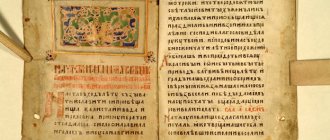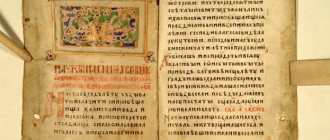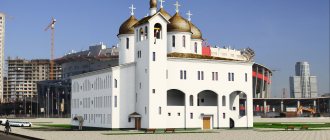Plot and theme
The theme of “Life...” is the choice of a person’s life path, not so much geographical as spiritual. In the introduction, Epiphanius the Wise explains the reasons that forced him to write “The Life of...”. The main part is the story itself about the saint, which consists of three parts: life, death and posthumous miracles.
Epiphanius the Wise truthfully describes the difficult political situation in which Sergius of Radonezh began his righteous activity. He immediately supported the Moscow princes, especially Dmitry. Sergius of Radonezh blesses Prince Dmitry for the fight against Mamai and the Golden Horde. Even during his lifetime, Sergius of Radonezh began to be revered as a saint of the Russian land.
Moscow Sretenskaya Theological Academy
Priest Jonah Skripnik 10/05/20178106
Lives of saints are an interesting, but difficult genre of ancient Russian writing. And therefore, understanding its specifics can help you comprehend what you read differently. The Life of St. Sergius, authored by St. Epiphanius the Wise, is no exception. The conditions for its writing and artistic features will be discussed in this article.
Hegumen of the Russian Land The lives of saints were one of the favorite readings in Ancient Rus'. They were read by both old and young, poor and rich, commoners and great princes.
M.V. Vetrova, a modern researcher of Russian literature abroad and, in particular, the work of B.K. Zaitsev and I.S. Shmelev, considers it necessary to stipulate the following: “The first original ancient Russian lives were intended for liturgical use, but not as a church sermon , and in the form of a prologue (from the book “Prologue”, which is a collection of abbreviated lives of saints, as well as instructive words arranged by day of the year. - Ed.
) notes or “memories” about the saint, which were read during the service. The purpose for which these works were created predetermined their form: they are presented in concise language, due to which the actual content of the life comes to the fore"[1].
Life, being a religious and artistic genre, in its main purpose and role in society, was an instrument of moral and religious didacticism.
It must be said that the works of Epiphanius the Wise, and primarily the lives of St. Stephen of Perm and St. Sergius of Radonezh, are among the most famous ancient Russian monuments created in the 15th century.
The Life of St. Sergius has been preserved in several literary versions, and lists of its short editions actually date back to the 15th century. And the earliest list of lengthy editions dates back only to the mid-20s of the 16th century. Its most famous list, richly and lavishly illustrated with miniatures, was created only in the last fifteen years of the 16th century.
Judging by the title, it is the lengthy hagiographical version that was written by the Monk Epiphanius the Wise around 1418-1419. However, unfortunately, the author's original has not been preserved in its entirety. V. M. Kirillin o[2]. Moreover, this work was already in the 15th century. It was edited by another famous ancient Russian scribe - Hieromonk Pachomius Serb (Logothetus), who created several editions of this life.
One way or another, the work was created at a time when the development of Russian hagiography was taking a different direction. At this time, according to M.V. Vetrova, “the main task of the author of the life is not to preserve the historical memory of the saint, but to draw spiritual and moral lessons from his life”[3]. In other words, hagiography, being a religious and artistic genre, in its main purpose and role in society, was an instrument of moral and religious didacticism. Thus, this genre had a dual purpose: “On the one hand, a description of the biography of saints, on the other, the religious education of the people in the spirit of Orthodoxy, and the second intention transformed the first. It is this fact that explains the idealization of saints as characters who demonstrate through their behavior the moral ideal of man prescribed by the church, which is directly reflected in the linguistic embodiment of the saint.”[4].
In this regard, the style of hagiographic works changes: they take on the character of a church sermon, rich in rhetorical techniques. At the same time, in the lives of the time in question, the accuracy of the presentation of historical events was often ignored in favor of a style called “weaving words” (“twisting words”). Having its origins in ancient rhetoric and poetics, it combines increased emotionality and expression with abstraction and abstraction of theological thought. This style is characterized by the desire to describe the particular through the general and eternal. The texts contain numerous analogies from sacred history, and the narrative is replete with quotations from the Bible. If possible, everyday vocabulary, names of specific natural phenomena, and some historical references are removed from literary works. The style of “weaving words” is distinguished by increased attention to the word: to its sound side, origin, subtleties of meaning, as well as to the search for new means of lexical expressiveness, in particular, the presence of cripples from the Greek language in the text[5].
The master of the style of “weaving words”, who, in fact, proposed this term, was precisely the Monk Epiphanius the Wise. He is one of the outstanding, encyclopedically educated and unusually talented people of his time. Moreover, this was already noted by ancient Russian scribes, who gave him the nickname of the Wise (it is found in the title of some lists of the life of St. Sergius of Radonezh).
One of the unique features of the work of Epiphanius the Wise is that he turned to creating the life of Sergius of Radonezh immediately after his death.
Epiphany was closely acquainted with many outstanding contemporaries: Stefan of Perm, Sergius of Radonezh, icon painters Theophanes the Greek, probably Andrei Rublev, etc. One of the unique features of his work is that he turned to creating the life of Sergius of Radonezh immediately after his death, long before official canonization, apparently realizing both the importance and necessity of hagiographic work, and the fact that such a difficult task was within his power.
Venerable Epiphanius the Wise In his writings, Epiphanius mentions many details of his life.
And this manifestation of the author’s principle, which is generally not typical for ancient Russian literature, speaks of his bright individuality, which makes the figure of the author even more interesting. As for the genre of Epiphany's works, despite the obvious specificity, it is quite traditional. However, his texts are characterized by a number of linguistic and artistic features, which distinguishes them from most works of this genre[6].
The vastness of the life of St. Sergius is explained by the presence of numerous quotations, digressions and excursions, as well as various rhetorical figures and devices, which significantly increases the volume of the work, on the one hand, and is a characteristic feature of the style of “weaving words”, on the other.
In this work, Epiphanius’s inclination towards a historical and symbolic interpretation of events is completely obvious. However, there are no deviations from the main narrative. In addition, the text is rich in factual data and contains a large number of names of contemporaries of St. Sergius, which can be explained by Epiphanius’s many years of life in the Trinity Monastery, close acquaintance with the place of the events described and the opportunity to use the testimonies of people who personally knew the saint (as already mentioned)[7] .
The range of sources used by Epiphanius has not yet been fully determined: first of all, these are the lives of St. Euthymius the Great, Saints Theodore of Edessa, Nicholas of Myra and others: “With the usual care of Epiphanius, he wrote it [the life] on the basis of documentary documents he had collected over 20 years data, records he made (“scrolls” “for the sake of reserve”) of his memories and eyewitness accounts. Owning patristic literature, biblical books, Byzantine and Russian hagiographical works, historical and other materials... and having organically mastered the traditions of South Slavic and Russian hagiography, Epiphanius masterfully applied the rhetorically sophisticated style of “weaving words”, with its inherent chains of various epithets, comparisons, and an abundance of rhetorical figures, combining stylistic sophistication with clarity and dynamism of plot development and sometimes with an unusually simple language, close to everyday colloquial" [8].
Following etiquette was manifested, in particular, in creating the image of the author.
From the point of view of textual criticism, the works of Epiphanius have been studied very little, although this topic is extremely productive.
After all, not one of Epiphanius’s works has survived to the present day in the original, and the earliest surviving copies date back to the time of creation. During rewriting, corrections were made to them; they, of course, contain many errors, which is typical for the handwritten tradition of the text. Apparently, for some reason, the edition of Epiphanius was not rewritten, as already mentioned, throughout the entire 15th century. And only at the beginning of the 16th century. Old Russian scribes discovered the first part of the Epiphanius edition (the preface and the first 10 chapters), it was supplemented with chapters from the Pachomiev editions - and so a new edition of the Life of Sergius was created, which received the name Extensive in science. A researcher of ancient Russian lives, A.V. Dukhanina, points out: “This edition was subsequently included in the Great Menaions of Chetya, and it was this edition that was supplemented with miracles of the 16th and 17th centuries. Old Russian scribes of the 17th century. German Tulupov and Simon Azaryin”[9]. Thus, textual problems associated with the life of Sergius of Radonezh make many of the researchers’ conclusions controversial and even erroneous.
The unique literary style of Epiphanius the Wise is a reflection in the text of the practice of unceasing prayer and the associated features of the author’s worldview.
In addition, for analyzing the life, it is important to remember: it, like almost all genres of ancient Russian literature, was subject to the laws of literary etiquette, which was composed “of ideas about how this or that course of events should have taken place;
from ideas about how the actor should have behaved in accordance with his position; from ideas about what words the author should use to describe what is happening”[10]. Following etiquette was manifested, in particular, in creating the image of the author. In hagiographic literature it is closely dependent on the characteristics of the genre. In the art of the Russian Middle Ages, as D.S. Likhachev noted, “the author, to a much lesser extent than in modern times, is concerned with introducing his individuality into the work”[11]. The hagiographer writes about his desire to “tell about the life of the righteous elder,” for “if the life is written, then, having heard about it, someone will follow the example of the life of Sergius and will benefit from it.” The author, who sets himself a similar goal, acts “not as an observer who has studied and pondered the described phenomena in the silence of his cell, but as a speaker from the church pulpit in front of numerous listeners”[12]. At the same time, Epiphanius points out that he undertook to write the life not for the sake of his own glory, but out of love for the saint. Speaking about himself, the author uses a number of belittling epithets; calls himself “weak”, “rude”, “unworthy”, “cursed”, “unreasonable”, “impudent”. Epiphanius does not take credit for the creation of his life, but emphasizes that without God’s help he would not have been able to describe “the many works of the elder and his great deeds.”
In conclusion, it is worth saying: the unique literary style of Epiphanius the Wise is a reflection in the text of the practice of unceasing prayer and the associated features of hesychast (here - ascetic - Ed.)
) the author’s worldview[13]. The Russian hagiographer adopts the ideas and literary techniques of the ancient hesychast authors and adapts them to his own style. Finally, it must be repeated once again: Epiphanius’ work organically fits into the style of his era, which is associated with the ethics and aesthetics of hesychasm (a developed system of ascetic and monastic practice aimed at knowledge of God and deification[14]).
Priest Jonah Skripnik
Keywords:
life, Sergius of Radonezh, Epiphanius, genre, features, weaving of words.
[1] Vetrova M.V.
Hagiographic and historiographical in Boris Zaitsev’s essay “Reverend Sergius of Radonezh” // URL: https://www.stsl.ru/news/all/agiograficheskoe-i-istoriograficheskoe-v-ocherke-borisa-zaytseva-prepodo... (access date: 02/13/2017).
[2] Kirillin V. M.
Epiphanius the Wise: Life of Sergius of Radonezh // URL: www.portal-slovo.ru/philology/37338.php (access date: 02/13/2017).
[3] Vetrova M.V.
Hagiographic and historiographical in Boris Zaitsev’s essay “Reverend Sergius of Radonezh” // URL: https://www.stsl.ru/news/all/agiograficheskoe-i-istoriograficheskoe-v-ocherke-borisa-zaytseva-prepodo... (access date: 02/13/2017).
See also: Klyuchevsky V. O.
Old Russian lives of saints as a historical source. - M., 1871. — P. 312
[4] Zavalnikov V.P.
The linguistic image of a saint in ancient Russian hagiography (problems of the mutual conditionality of the linguistic and extralinguistic content of a person’s linguistic image in a certain sociocultural situation): Abstract. dis. Ph.D. Philol. Sci. - Omsk, 2003. - P. 11.
[5] See in more detail, for example: Zhukovskaya L.P.
On the question of the South Slavic influence on Russian writing: (Life of Anisya according to the lists of 1282-1632) // History of the Russian language: Research and texts.
- M.: Nauka, 1982. - P. 277-287; Zhukovskaya L.P.
About the South Slavic influence of the XIV-XV centuries. (Based on the material of the prologue Life of Eugenia) // Language and writing of the Middle Bulgarian period. - M.: Nauka, 1982. - P. 26-59.
[6] Monuments of literature of Ancient Rus'. XIV - mid-XV centuries. - M.: Fiction, 1981. - P. 52.
[7] Droblenkova N. F., Prokhorov G. M.
Epiphanius the Wise. Life of Sergius of Radonezh // Dictionary of scribes and bookishness of Ancient Rus'. Vol. 2 (second half of the XIV - XVI centuries). Part 1: A-K. - L.: Nauka, 1988. - P. 28.
See also: Kirillin V.M.
On the state of Russian society and statehood in the time of St. Sergius of Radonezh and the significance of his spiritual feat // Sretensky collection. Vol. 5. - M.: Sretensky Monastery Publishing House, 2014. - P. 176-200.
[8] Life of Epiphanius. Part I. Life of Epiphanius. Part II // Pustozersky collection: Autographs of the works of Avvakum and Epiphanius. - L.: Nauka, 1975. - P. 199, 202.
[9] Dukhanina A. V
. “Modern hagiographic literature and ancient Russian hagiographic literature are two completely different things” // URL: https://ruvera.ru/articles/aleksandra_duhanina_sovremennaya_jitiiynaya_literatura (access date: 04/04/2015).
See also: Kloss B.M.
Lives of Sergius and Nikon of Radonezh in Russian writing of the 15th-17th centuries // Methodological recommendations for the description of Slavic-Russian handwritten books. Vol. 3. - M., 1990. - P. 278.
[10] See ibid. P. 293; Itskovich T.V.
Genre systematization of religious style on communicative-pragmatic and categorical-textual grounds: Author's abstract. dis. ... doc. Philol. Sci. - Ekaterinburg, 2021. - P. 11.
[11] Likhachev D. S
. Poetics of Old Russian Literature // Likhachev D.S. Selected works. In 3 volumes. T. 1. - L.: Fiction, 1987. — P. 333.
[12] Klyuchevsky V. O.
Old Russian lives of saints as a historical source. - M.: Grachev Printing House and Comp., 1871. - P. 403.
[13] See in more detail, for example: Avlasovich S. M.
Literary style of Epiphanius the Wise: Abstract. dis. ...cand. Philol. Sci. - Omsk, 2007.
[14] Torchinov E. A.
Religions of the world: Experience of the beyond. Dogmatic religions of revelation. - St. Petersburg: Center "Petersburg Oriental Studies", 1998. - P. 478.
Composition
Miracles accompanied the saint from his very birth. His parents named him Bartholomew and determined to serve God. He was not good at reading, but one day he met a monk who, in response to his complaint, gave him a prosphora and said that he would read better than anyone else. And so he did. And the monk predicted that the boy would serve God.
In his youth, the boy strictly observed fasts, read a lot and strove for the monastic life. When his parents died, the boy went into the forest, where he built a monastery.
He was twenty years old when he took monastic vows under the name Sergius, and continued his service to God in the hermitage, constantly experiencing the onslaught of various demons, from which prayer saved him. Many monks asked Sergius to allow them to live next to him, when there were twelve of them, they built a fence around them and asked him to be their abbot. Monastic life proceeded in works and prayers. Sergius was the first to endure all hardships and taught patience to the brethren.
Miraculously, at the request of the brethren, a source on the territory filled up with Sergius’ prayers. He resurrected a dead boy and cast out a demon from a nobleman. A wonderful vision in the form of birds suggested to the abbot the idea of expanding the monastery. Sergius had grateful disciples who dispersed throughout the Russian land and founded new monasteries. And Sergius blessed everyone.
When Prince Dmitry of Moscow decided to go to battle with Khan Mamai, he came to Sergius for advice and blessing. He blessed and gave two monks to help. The miracle was the appearance of the Mother of God to Sergius, who said that she would never leave the monastic monastery. The miracles performed by Sergius' prayers continued, and rumors of his miraculous power spread throughout the Russian land.
When Sergius felt his death approaching, he entrusted the management of the monastery to his disciple Nikon, and he himself fell into silence for six months. Before his death, he taught the brethren and asked to be buried outside the church. However, his will was violated and he was buried in the temple on the right side in front of a large crowd of Russian people.









